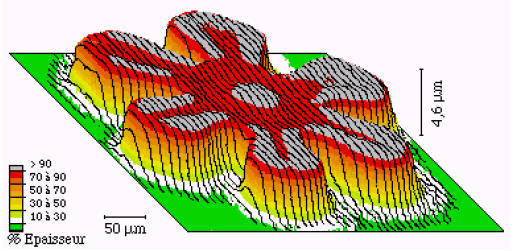
Free growth of a discotic liquid crystal
Collaboration with
Patrick
Oswald
(PhD
advisor),
John
Bechhoefer, Pierre Pelcé,
and
Dmitrii
Temkin.
Summary
We studied the free growth of a discotic liquid crystal (hexaoctyloxytriphenylene) in thin samples and homeotropic anchoring. An efficient quenching of the sample and a new three-dimensional vizualization mehod of the germs (Fig.1) make possible the quantitative study of both the dendritic and cellular (up to absolute restabilization of the growth front) regimes.

Fig.1: 3D-reconstruction of a growing germ (from figure 2, left).
In the first regime, for supersaturations lower than 0.7, there are two types of dendrites, depending on the ratio R of the impurities diffusion-length to the sample thickness. For R larger than 50, the stationary dendrites are two-dimensional, and their characteristics (Peclet number and stability constant) are in agreement with the 2D-theory (Fig.2, left). For R less than 10, the dendrites are three-dimensional, as a layer of liquid appears between them and the limiting glass plates (Fig.2, right). In this case, the stability constant decreases and tends to a well-defined value when R is less than 1. Nevertheless, the Peclet number never obeys to the three-dimensional Ivantsov's law. That proves that they are confined. For supersaturations between 0.7 and 1, the density of the side-branches increases, the dendritic solution vanishes, and a dense-branching regime results.
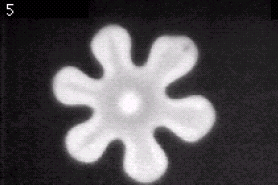
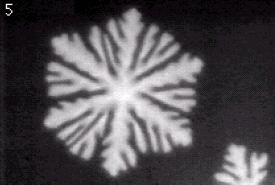
Fig.2: 2D (left) and 3D (right) dendrites.
In the kinetic regime, for supersaturation larger than 1, the growth front is first cellular (Fig.3, left) and then restabilizes (Fig.3, right) when the supersaturation passes 4. We have measured the molecular attachment kinetic coefficient and its anisotropy. We found that the easy growth axes at low and large velocities make a 30 degrees-angle between them.
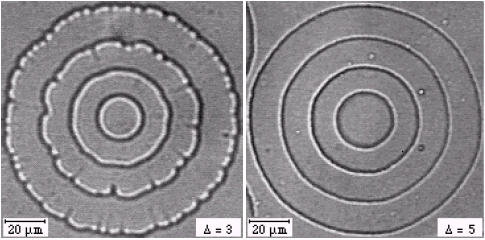
Fig.3:
Unstable
(left) and
stable
(right)
growth
fronts in
the
kinetic
regime.
The
pictures
show the
superimposition
of 4
snapshots
taken with
a constant
time
interval.
Finally, we present an additional study of the front kinetics in directional growth. In particular, we have observed evidence of an anchoring transition at large velocities which leads to a non-linear kinetic law when the molecular columns are perpendicular to the growth front (Fig.4).
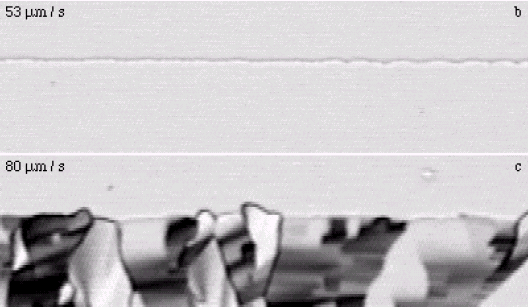
Fig.4:
Snapshot
of the
growth
front
below (b)
and above
(c) the
anchoring
transition.
The
crystal
[underneath
the front
(line)]
growths to
the top of
the
pictures.
Related publications
Croissance
libre de
la phase
colonnaire
hexagonale
d'un
cristal
liquide
discotique,
J.C. Géminard,
PhD
thesis,
Université
Claude
Bernard
-
Lyon I
(1993).
(Download
the PDF,
in French)
On wetting and
apparently asymmetric kinetics in free growth,
J.C. Géminard, J. Bechhoefer and P. Oswald, J. Cryst. Growth 114
(1991) 640-646.
Statistical
approach for radial fingering in a Hele-Shaw cell,
J.C. Géminard and P. Pelcé, J. Phys. II France 2
(1992) 1931-1940.
Rapid
solidification of a columnar hexagonal liquid crystal,
J.C. Géminard, P. Oswald, D. Temkin and J. Malthęte, Europhys.
Lett. 22 (1993) 69-75.
An improved
directional growth apparatus for liquid crystals:
applications to thermotropic and lyotropic systems,
P. Oswald, M. Moulin, P. Metz, J.C. Géminard, P. Sotta and L.
Sallen, J. Phys. III France 3 (1993) 1891-1907.
Kinetic dendrite
in the boundary-layer model,
D. Temkin, J.C. Géminard and P. Oswald, J. Phys. I France 4
(1994) 403-409.
Three-dimensional
vizualization and physical properties of dendrites
in thin
samples of a hexagonal columnar liquid crystal,
J.C. Géminard and P. Oswald, J. Phys. II France, 4
(1994) 959-974.
Equilibrium
shape of an anisotropic crystal confined between two planar
surfaces,
J. C. Géminard and P. Oswald, Phys. Rev. E., 55
(1997) 4442.